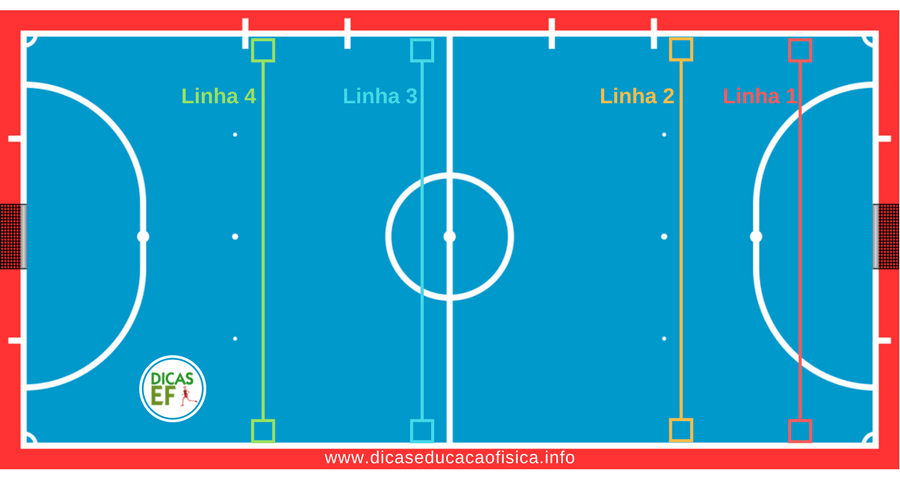Introduction: Types of Futsal Defense
In this article, DEF presents the types of Futsal Defense: Individual defense, Zone defense, Mixed defense and the positions of the Futsal defensive lines.
What is the goal of Futsal defensive system?
A good Futsal defensive system is one that provides effective marking on the opposing team. The goal of Futsal marking is to prevent the opponent from making successful offensive plays, without committing fouls. The Futsal rules will punish the excess of fouls with direct free kick; therefore, marking must be efficient but not excessively aggressive.
Fouls and Futsal Defensive System
Having a good defensive system is the best way to avoid excessive fouls in a Futsal game. If athletes are well aware of their roles and defense positions, marking will be much more of a tactical issue than of aggression, and this will prevent an excessive number of fouls.
Physical Preparation and Futsal Defensive System
With the development of physical preparation, Futsal marking has also evolved a lot, as currently Futsal athletes can fill the spaces more efficiently. In addition, they are stronger and are able to better follow the opponents’ offensive moves.
Elements of the Futsal Defensive System
The defensive system of Futsal consists of the types of marking (how to mark), and of the defensive lines or defensive variations (where it is marked). A Futsal team can mark individually (man-to-man), by zone or by mixed zone.
Individual Defense in Futsal
Individual Defense in Futsal is called “man-to-man defense”, that is, each player will receive a specific opposition player to score, anywhere in the field.
Positive aspects of Individual Defense:
- Hinders free kick (long kick);
- Descreases pass options;
- Forces the opponent to make mistakes;
- increases opponent’s physical exhaustion, as they need to make more moves in order to escape from marking;
- decreases the opponent’s ball possession time;
- decreases the opponent’s reaction time to think about which move to make.
Negative aspects of Individual Defense:
- promotes great physical exhaustion to the defenders in order to keep up with the attacker’s moves;
- leaves mid-court free, making it easier for free kicks, ball-pass behind the defender;
- the opposing team may be in numerical advantage when they get a dribble, making it difficult for recovering and backing up.
Defense by Zonal in Futsal
In Defense by Zonal, each defender is responsible for marking an area of the court, the opposing player that occupies that area will be marked. In zonal marking, the defender must not follow the opponent across the court, they must only follow the opponents who enter their marking zone. It is used when the opposing team has good moves, along with pass exchanges, or when the team is winning. For a good zonal marking, it is required intense training.
Positive aspects of Defense by Zonal:
- makes it easier for backing up and recovering the ball in the case of a dribble;
- less physical exhaustion on defenders;
- provides good chances of counter attack;
- makes it harder to occur a ball-pass behind the defender and better-organizes mid-court.
Negative aspects of Defense by Zonal:
- enables free kick (long kick);
- increases the time of ball possession of the opposing team;
- may partially hinder the goalkeeper’s vision.
Mixed Defense on Futsal
The mixed defense is the one that uses zone marking combined with man marking; it basically comes down to marking an opponent individually, while the other players are marked by zone.
Defensive System 2×2 or Square Formation
The defensive system 2×2 or Square formation is the type of marking used against teams that use the tactical system 2×2 or 4×0. Two players are positioned ahead and maintain their positions, only touching opponents who “enter” their zone. The two players in the back will mark the two most advanced players on the opposing team.
Defensive Lines and Defensive System of Futsal
The defensive lines in Futsal are associated with the idea of space; the more advanced the defensive line, the less space is left for the opposing team to play.
First defensive line
The first defensive line or line 1, is the one in the opponent’s defense court, close to the opponent’s goal, the so-called pressure marking, in order to prevent the opponent’s ball out. Thus, the first defensive line marking is a type of marking that leaves little room for the opponent to play.
Second Defensive Line
The second defensive line in Futsal or line 2 is the half-pressure type of marking. In this defensive position, the goalkeeper has a little more room to exit the ball, however, as soon as the ball is dominated by an opposing player, the team advances to the first line of defense, increasing the pressure in the marking.
Third Defensive Line
The third defensive line in Futsal or line 3 is the half-court type of marking, because in this defensive position, the team positions itself from the middle of the court, leaving the opponents unmarked in their defensive zone, but when the opponents enter the attack zone, they suffer strong marking. The aim of this defensive positioning is to avoid infiltration, “ball-pass from behind the defender”, to better organize mid-court and to play in the counterattacks.
Fourth Defensive Line
The fourth defensive line in Futsal or line 4 is a type of positioning defensive enough retracted, located near the line of 10 meters in the defense zone. In this system, the opposing team will have plenty of space to keep the ball, however, they will not have spaces for infiltrations or to play a one-two. The aim of this defensive positioning is also the counter-attack game.
